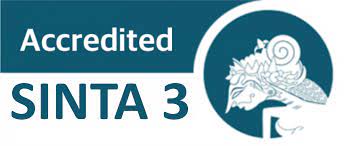Modeling Instruction to Promote Student’s Understanding of System and Model of System of Mechanical Energy
Abstract
Understanding of system and model of the system are necessary for conducting an analysis of scientific phenomena. One concept in science that requires system is energy. This research aimed to understand how modeling instruction promoted increasing student’s understanding system and model of a system on mechanical energy material. Research was conducted on 30 students of MIA at SMAN 1 Kertosono. The result showed that student’s understanding of the system and model of the system increased significantly. Series of learning in class showed that at every meeting session, student skill increased from novice to expert. They were able to show how important the system explain the mechanism of energy transfer were. Average N-gain 0.32 (medium category) indicated that modeling instruction was good enough to promote student understanding of the system. Moreover, any misconception about energy was able to prevent and overcome by this learning. By learning, student’s skill to solve new problem had changed approaching expert problem solver.
كان فهم أنظمة ونماذج الأنظمة ضروريًا لإجراء تحليل لظواهر العلوم. واحدة من المفاهيم في العلوم التي تتطلب النظام كانت الطاقة. يهدف هذا البحث إلى فهم كيفية تعزيز إرشادات النمذجة فهم الطلاب لأنظمة ونماذج الأنظمة على مواد الطاقة الميكانيكية. أجريت البحوث على 30 طالب من MIA 1 في SMAN 1 Kertosono. أظهرت النتيجة أن فهم الطلاب لنظام ونموذج النظام زاد بشكل كبير. أظهر تسلسل التعلم في الفصل كل جلسة اجتماع ، زادت مهارة الطلاب من المبتدئ إلى الخبير. يمكنهم شرح آلية نقل الطاقة. يشار إلى متوسط N-gain 0.32 (الفئة المتوسطة) أن النمذجة جيدة بما فيه الكفاية لتعزيز فهم الطلاب للنظام. علاوة على ذلك ، كان أي سوء فهم حول الطاقة قادراً على منع هذا التعلم والتغلب عليه. من خلال التعلم ، مهارة الطالب لحل مشكلة جديدة تقترب من حلول المشاكل.
Keywords
Full Text:
PDFReferences
Akerson, V. L., White, O., Colak, H., & Pongsanon, K. (2011). Relationships Between Elementary Teachers’ Conceptions of Scientific Modeling and the Nature of Science. In M. S. Khine & I. M. Saleh (Eds.), Models and Modeling (pp. 221–237). Dordrecht: Springer Netherlands. https://doi.org/10.1007/978-94-007-0449-7_10
Arends, R. (2012). Learning to teach (9th ed). Dubuque, Iowa: McGraw-Hill.
Brewe, E., Kramer, L., & O’Brien, G. (2009). Modeling instruction: Positive attitudinal shifts in introductory physics measured with CLASS. Physical Review Special Topics - Physics Education Research, 5(1). https://doi.org/10.1103/PhysRevSTPER.5.013102
Chi, M. (1989). Self-explanations: How students study and use examples in learning to solve problems. Cognitive Science, 13(2), 145–182. https://doi.org/10.1016/0364-0213(89)90002-5
Constantinou, C. P., & Papadouris, N. (2012). Teaching and learning about energy in middle school: an argument for an epistemic approach. Studies in Science Education, 48(2), 161–186. https://doi.org/10.1080/03057267.2012.726528
Dalaglioglu, S., Demirci, N., & Sekercioglu, A. (2015). Eleventh Grade Students’ Difficulties And Misconceptions Baout Energy and Momentum Concept. International Journal on New Trends in Education and Their Implications, 6(1).
Develaki, M. (2016). Key-Aspects of Scientific Modeling Exemplified by School Science Models: Some Units for Teaching Contextualized Scientific Methodology. Interchange, 47(3), 297–327. https://doi.org/10.1007/s10780-016-9277-7
Docktor, J. L., & Mestre, J. P. (2014). Synthesis of discipline-based education research in physics. Physical Review Special Topics - Physics Education Research, 10(2). https://doi.org/10.1103/PhysRevSTPER.10.020119
Fakhriyah, F., Masfuah, S., Roysa, M., Rusilowati, A., & Rahayu, E. S. (2017). Student’s Science Literacy in the Aspect of Content Science? Jurnal Pendidikan IPA Indonesia, 6(1). https://doi.org/10.15294/jpii.v6i1.7245
Hake, R. R. (1998). Interactive-engagement versus traditional methods: A six-thousand-student survey of mechanics test data for introductory physics courses. American Journal of Physics, 66(1), 64–74. https://doi.org/10.1119/1.18809
Halloun, I. A., & Hestenes, D. (1987). Modeling instruction in mechanics. American Journal of Physics, 55(5), 455–462. https://doi.org/10.1119/1.15130
Hegde, B., & Meera, B. N. (2012). How do they solve it? An insight into the learner’s approach to the mechanism of physics problem solving. Physical Review Special Topics - Physics Education Research, 8(1). https://doi.org/10.1103/PhysRevSTPER.8.010109
Huis, C. van, & Berg, E. van den. (1993). Teaching energy: a systems approach. Physics Education, 28(3), 146–153. https://doi.org/10.1088/0031-9120/28/3/003
Jackson, J., Dukerich, L., & Hestenes, D. (2008). Modeling Instruction: An Effective Model for Science Education. Science Educator, 17(1), 10–17.
Karpin, T., Juuti, K., & Lavonen, J. (2014). Learning to apply models of materials while explaining their properties. Research in Science & Technological Education, 32(3), 340–351. https://doi.org/10.1080/02635143.2014.944494
Keeports, D. (2017). Locating gravitational potential energy. Physics Education, 52(1), 013007. https://doi.org/10.1088/1361-6552/52/1/013007
Lin, S.-Y., & Singh, C. (2011). Using isomorphic problems to learn introductory physics. Physical Review Special Topics - Physics Education Research, 7(2). https://doi.org/10.1103/PhysRevSTPER.7.020104
Mustofa, Z., Sutopo, & Mufti, N. (2016). Pemahaman Konsep Siswa SMA Tentang Usaha dan Energi Mekanik (Vol. 1, pp. 519–528). Presented at the Seminar Nasional Pendidikan IPA Pascasarjana UM, Malang: Pascasarjana UM.
National Research Council (U.S.) (Ed.). (2012). A framework for K-12 science education: practices, crosscutting concepts, and core ideas. Washington, D.C: The National Academies Press.
Next Generation Science Standards: For States, By States. (2013). Washington, D.C.: National Academies Press. https://doi.org/10.17226/18290
Ogilvie, C. A. (2009). Changes in students’ problem-solving strategies in a course that includes context-rich, multifaceted problems. Physical Review Special Topics - Physics Education Research, 5(2). https://doi.org/10.1103/PhysRevSTPER.5.020102
Purwani, L. D., Sudargo, F., & Surakusumah, W. (2018). Analysis of student’s scientific literacy skills through socioscientific issue’s test on biodiversity topics. Journal of Physics: Conference Series, 1013, 012019. https://doi.org/10.1088/1742-6596/1013/1/012019
Slavin, R. E. (2006). Educational psychology: theory and practice (8th ed). Boston: Pearson/Allyn & Bacon.
Treagust, D. F., Chittleborough, G., & Mamiala, T. L. (2002). Students’ understanding of the role of scientific models in learning science. International Journal of Science Education, 24(4), 357–368. https://doi.org/10.1080/09500690110066485
Walsh, L. N., Howard, R. G., & Bowe, B. (2007). Phenomenographic study of students’ problem solving approaches in physics. Physical Review Special Topics - Physics Education Research, 3(2), pp. 1-31. https://doi.org/10.1103/PhysRevSTPER.3.020108
DOI: https://doi.org/10.18860/abj.v3i1.5939
Refbacks
- There are currently no refbacks.
Copyright (c) 2018 Abjadia : International Journal of Education

This work is licensed under a Creative Commons Attribution-NonCommercial 4.0 International License.
...............................................................................................................................................................
Mailing Address:
Ruang Jurnal Abjadia, Fakultas Ilmu Tarbiyah dan Keguruan (FITK)
Universitas Islam Negeri (UIN) Maulana Malik Ibrahim Malang
Jalan Gajayana 50 Malang 65144, Jawa Timur, Indonesia
Phone/Faximile: (+62341) 552398, Cell Phone: +62 81 333 666 063
Website: http://ejournal.uin-malang.ac.id/index.php/abjadia
Email: abjadia@uin-malang.com
Abjadia: International Journal of Education. This work is licensed under a Creative Commons Attribution-ShareAlike 4.0 International License.
...............................................................................................................................................................
Indexed by:






